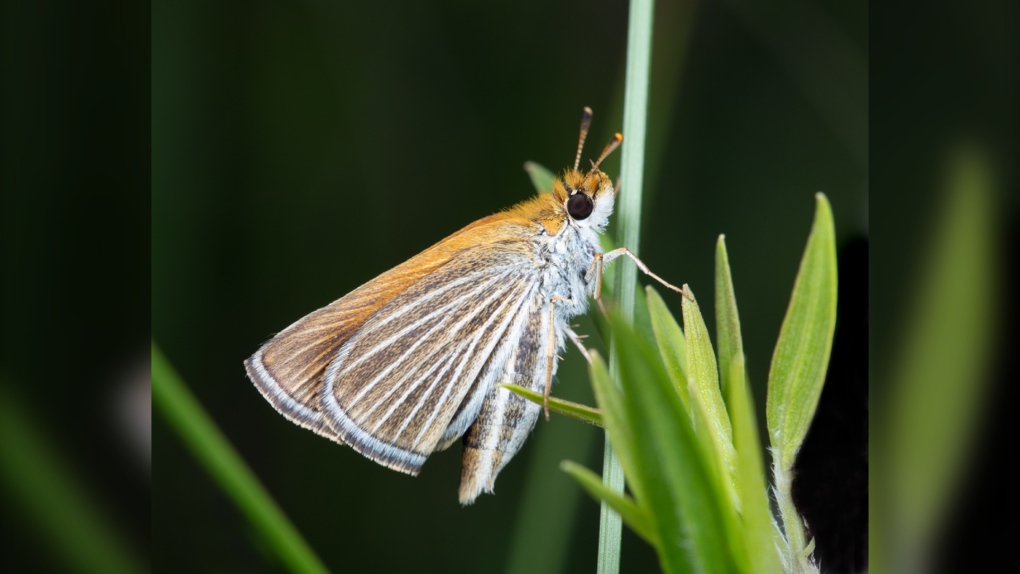More than 200 endangered butterflies released in Manitoba this summer
 Poweshiek skipperling. (Source: David Pavlik)
Poweshiek skipperling. (Source: David Pavlik)
The Assiniboine Park Conservancy released more than 200 endangered butterflies back into the landscape this year.
The organization announced the results of its butterfly release program on Thursday, saying it set a new record with the release of 207 butterflies.
This year’s release included 191 critically endangered Poweshiek skipperling butterflies, which were released over three weeks in July at the Nature Conservancy of Canada’s properties in the Manitoba Tall Grass Prairie Preserve in the RM of Stuartburn.
This year’s program also included the release of 16 endangered Dakota skippers.
Ashleigh Westphal, a research conservation specialist with the Assiniboine Park Conservancy, said they are thrilled with the results of the breeding and release program, and are excited about what it means for the future of these endangered species.
“When we started the release program in 2018, experts estimated there were only about 100 Poweshiek skipperling butterflies remaining in all of Canada,” Westphal said.
“We released six butterflies that year. The growth of the program and results so far are very encouraging, but we have a long way to go before this species will be secure in the wild.”
This is the fifth year the conservancy released Poweshiek skipperling, and the first time for the Dakota skippers.
This summer, the Assiniboine Park Conservancy released more than four times the number of adult butterflies it released in 2021.
The conservancy said the ongoing success of its breeding program will help the future of these endangered butterflies.
“We have seen encouraging results from our population surveys in locations where we have done releases. This suggests our efforts may be helping to stabilize the population at these specific sites. However, we will need to analyze the new data collected this summer to get a better picture of the trends,” Westphal said.
“In the future, we hope to work with partners to reintroduce Poweshiek to sites where they have been lost."
Both Poweshiek skipperling and Dakota skippers are habitat specialists, which means they need specific grassland ecosystems to survive. However, much of this habitat has been lost.
The organization notes that habitat loss, as well as climate change, extreme weather events, and the increased use of pesticides, have contributed to population declines.
CTVNews.ca Top Stories

Southern California wildfire destroys many structures; governor declares state of emergency
A wildfire whipped up by extreme winds swept through a Los Angeles hillside dotted with celebrity residences Tuesday, burning homes and forcing the evacuation of tens of thousands of people.
Trump is open to using 'economic force' to acquire Canada; Trudeau responds
Prime Minister Justin Trudeau said 'there isn’t a snowball’s chance in hell that Canada would become part of the United States,' on the same day U.S. president-elect Donald Trump declared that he’s open to using 'economic force' to acquire Canada.
A B.C. mom's real-life nightmare and the search to find her trafficked daughter
A Vancouver island mom shares the story of what happened to her teenaged daughter – and a warning for other parents about sex trafficking.
Liberal leadership hopeful Frank Baylis noncommittal on eliminating consumer carbon tax
Liberal leadership hopeful Frank Baylis says eliminating the consumer carbon tax alone will not 'solve the affordability issue for Canadians.'
Canadian naval vessel shadowed by Chinese war ship in the East China Sea
CTV National News is on board the HMCS Ottawa, embedded with Canadian Navy personnel and currently documenting their work in the East China Sea – a region where China is increasingly flexing its maritime muscle. This is the first of a series of dispatches from the ship.
Patient dies in waiting room at Winnipeg hospital
An investigation is underway after a patient waiting for care died in the waiting room at a Winnipeg hospital Tuesday morning.
Limit coffee-drinking to this time window to lower early death risk, study suggests
Drinking coffee has repeatedly been linked with better heart health and prolonged life. But the benefits of coffee consumption could depend on when you drink it, new research has found.
B.C. 'childbirth activist' charged with manslaughter after newborn's death
A British Columbia woman who was under investigation for offering unauthorized midwifery services is now charged with manslaughter following the death of a newborn baby early last year.
Man who exploded Tesla Cybertruck outside Trump hotel in Las Vegas used generative AI, police say
The highly decorated soldier who exploded a Tesla Cybertruck outside the Trump hotel in Las Vegas used generative AI including ChatGPT to help plan the attack, Las Vegas police said Tuesday.


































